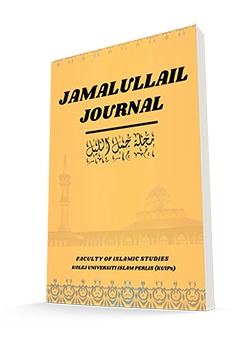Transformasi Pembukuan Al-Quran: Dari Tradisi Lisan ke Inovasi Digital
The Transformation of Qur’anic Compilation: From Oral Tradition to Digital Innovation
Keywords:
Qur’an, Compilation, Digitalization, Inclusive Access, AccessibilityAbstract
The Qur’an, as the supreme source of Islamic guidance, has experienced a dynamic evolution in its methods of compilation, transitioning from oral traditions during the Prophet Muhammad’s (PBUH) era to contemporary digital innovations. This study was conducted to address the growing need to understand how the Qur’an has been preserved across different historical phases without compromising its authenticity. The primary objective of this research is to examine the transformation of Qur’anic compilation from memorization and manual inscription to script standardization, early printing, and modern digitization while highlighting its continued relevance and accessibility in the digital age. This qualitative study employed document analysis through library research, utilizing classical and contemporary sources, scholarly journals, and digital archives. The findings reveal that although the medium has evolved, the integrity and content of the Qur’an remain unchanged. Furthermore, the development of mobile applications, online platforms, and special accessibility tools such as Braille Qur’an and sign language have significantly enhanced inclusive access to the scripture. In conclusion, this transformation illustrates the harmonious balance between tradition and technology in ensuring the preservation and dissemination of the Qur’an for future generations. This research also recommend future researchers to explore new innovations that help the Quran to be more accessbile while preserving its authenticity such as human chip implant, change of font, etc.
Downloads
References
Abd Ghani, A. R. H., & Abdullah, M. (2002). Pembaharuan dalam mashaf Rasm 'Uthmani: Suatu sorotan sejarah. Jurnal Usuluddin, 16, 105-118.
Abdul Hadi, A. Z., Wan Abdullah, W. N., Mohamad, S., & Abdul Latif, M. A. (2015). Analisis Isu-Isu Dalam al-Qira’at al-Shadhdhah. Islamiyyat, 37(1), 16–28. https://doi.org/10.17576/islamiyyat-2015-3701-02.
Abu Dawud, Sulaiman bin al-Asy’ath. 2009. Sunan Abi Dawud. T.T.P: Dar al-Risalah al-Alamiyyah.
Ali Muhammad, A. (2017). Sejarah Umawiyah dan Abbasiyah. Jakarta: Ummul Qurra.
Ali, R. (2010). Pengantar ulum al-Qur’an. Kuala Lumpur Pustaka Salam Sdn Bhd.
Al-Bukhari, M. I. (1993). Sahih al-Bukhari. Damsyik: Dar Ibn Kathir – Dar al-Yamamah.
Islam Su’al wa Jawab. 2008. Taqsim al-Mushaf ila Ajza’ wa Ahzab. Dicapai pada 13 Mei 2025, daripada: https://m.islamqa.info/ar/answers/109885 تقسيم-المصحف-الى-اجزاء-واحزاب
Jaafar, N., & Abdul Kadir, K. (2008). Pengajaran Braille al-Quran di Malaysia. In Seminar Warisan Quran dan Hadith Nusantara. Kuala Lumpur: Universiti Malaya.
Jasmi, K. A. & Selamat ‘A. (2013). Al-Quran Satu Mukjizat yang Menakjubkan in Penciptaan Manusia dari Perspektif al-Quran. Skudai, Johor Bahru: Universiti Teknologi Malaysia Press. ISBN 978-983-52-0915-4.
Kania, T. (2022). Sejarah Pembukuan Al-Quran. Academia, 1-10.
Karamah, U. (2019). Kaedah-kaedah Bacaan Al-Quran dalam Kalangan Orang Kurang Upaya Pendengaran. A-Turath, 59-66.
Malik ibn Anas. (1991). Al-Muwatta’. Beirut: Mu’assasah al-Risalah.
Mohamad, M. R., Adi, M. F. B. A., & Mohamad, N. K. B. (2019). Sejarah al-Quran: Tahap-tahap perkembangan pembaharuan tanda-tanda titik dan baris di dalam mashaf. Jurnal Pengajian Peradaban Islam, Kolej Universiti Islam Antarabangsa Selangor.
Mohamad, M. R., Ibrahim, N. M. N. @ N. H., & Abdul Manaf, M. F. (2017). Inovasi al-Quran: Kelebihan, cabaran dan solusi. Prosiding Persidangan Antarabangsa Pengajian Islamiyyat Kali Ke-3 (IRSYAD 2017) 367–374. Kolej Universiti Islam Antarabangsa Selangor.
Muhaysin, M. S. (2002). Irsyad al-Talibin ila Dabt al-Kitab al-Mubin. Kaherah: Dar al-Muhaisyn.
Muslim ibn al-Hajjaj. (1955). Sahih Muslim. Kaherah: Matba’ah ‘Isa al-Babi al-Halabi wa Sharikah.
Nasruddin. (2015). Sejarah penulisan Al-Quran: Kajian antropologi budaya. Jurnal Rihlah, 2(1), Jurnal Rihlah Vol. II No. 1 Mei 2015
Al-Qadi, A. F. (1994). Tarikh al-Mushaf al-Syarif. Jumhuriayyah Misr al-‘Arabiyyah, al-Matba‘ah al-Azhariyyah.
Al-Qadi, A. F. (1999). Sejarah al-Quran (I. Mohd Hassan, Trans.). Percetakan Yayasan Islam Terengganu Sdn. Bhd.
Al-Qattan, M. (2015). Mabahith fi 'Ulum al-Quran. Beirut: Muassasah al-Risalah.
Rahmah Razuan, R., Raus, N., Hashim, M., Rasdi, A., Yusoff, A., Ja'afar, N., & Muhamad, A. (2019). Pendidikan al-Quran bagi OKU: Pengalaman Pusat Penyelidikan Ibnu Ummi Maktum (UMMI). Journal of Islamic Social Sciences and Humanities, 78–98.
Al-Sabuni, M. A. (2012). Al-Tibyan fi 'Ulum al-Quran. Maktabah al-‘Asriyyah.
Sarwat, A. (2020 ). Sejarah Al-Quran . Lentera Islam , 13-20.
Solehah, S., Siti Hajjatul Wada, O., & Nuru Huurun Ain, A. A. (2023). Transformasi pembukuan al-Quran pada zaman Nabi sehingga kini. Penerbit USIM. https://fpqs.usim.edu.my/ms/e-proceeding/
Tajul Asmawee, N. F. A., Wan Maizon, W. S. N., Wan Alauddin, W. N. N. S., & Syed Hassan, S. N. (2024). Transformasi Digital dalam Pembelajaran dan Amalan Islam: Analisis Aplikasi Muslim Pro. Jurnal Penyelidikan Islam dan Kontemporari (JOIRC), 7(12), 1-18.
Yusoff, A. M. H. (2022). Keberkesanan pengajian al-Quran secara atas talian: Kajian dalam kalangan pelajar OUM Kelantan. International Journal of Education, Psychology and Counseling, 7(46).
Al-Zuhaili, W. (1991). Tafsir al-Munir. Beirut: Muassasah al-Risalah.
Downloads
Published
How to Cite
Issue
Section
License
Copyright (c) 2025 Aisyah binti Abdul Wahab, Dhiyaul Hafidh Fatah Yasin

This work is licensed under a Creative Commons Attribution 4.0 International License.





